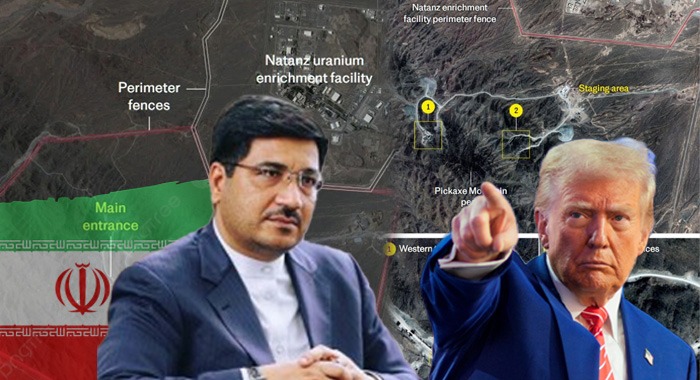At a time when former U.S. President Donald Trump confidently declares that “Iran can no longer build a nuclear weapon” and that “its uranium enrichment program lies in ruins,” Iranian officials continue to assert something very different, that their enriched uranium remains safe, their program resilient, and their intent unbroken.
Trump, speaking at the NATO summit in The Hague, stressed that the U.S. had launched successful strikes on Iran’s nuclear facilities, specifically targeting the Fordow enrichment site. He claimed that the “Fordow site is now nothing but rubble,” and reaffirmed America’s red line: If Iran restarts enrichment, it will face more attacks.
Backing him, U.S. Secretary of State Marco Rubio stated the strikes had “pushed Iran far from its nuclear weapon capabilities,” significantly damaging its infrastructure.
But that’s not the story coming out of Tehran.
The Claim from Tehran: “Our Uranium Is Untouched”
Iranian Foreign Ministry official Hassan Nourian pushed back hard against U.S. and Israeli claims, stating that the 400 kilograms of enriched uranium in Iran’s possession remained intact despite the aerial strikes.
According to Nourian, Iran had foreseen such an attack and took protective measures. “We moved critical assets before the bombing,” he said. He also accused Israel and the U.S. of failing in their bid to dismantle Iran’s nuclear program, emphasizing “solid evidence of Iran’s strategic victory.”
This directly leads to the burning question on many analysts’ minds:
Where exactly is Iran’s enriched uranium now?
The Underground Enigma: ‘Peak X’ and the Hidden Facility
Speculation has intensified around a mysterious location dubbed “Peak X”, known locally as Kohe-Koling Gazelleh, a mountain near Natanz in Isfahan province. It lies just 90 miles south of Fordow and has become the center of global nuclear anxiety.
According to multiple intelligence leaks and satellite imagery, Iran has constructed a vast underground complex beneath this mountain, reportedly deeper and more fortified than any previous site, including Fordow.
Western defense sources claim the underground chambers at Peak X extend more than 100 meters below ground, compared to Fordow’s 60-90 meters, making it potentially immune even to U.S. bunker-buster bombs.
A senior Israeli defense expert, Sima Shine, believes Iran transferred advanced centrifuges and enriched uranium here just before the strikes. This claim is supported by reports that 16 trucks were seen leaving Fordow days before the bombing.
IAEA Director-General Rafael Grossi had previously questioned Iran about this site in April 2025 but was told flatly: “This is none of your concern.”
According to Western nuclear analysts, Iran no longer relies on a few centralised enrichment sites. Instead, it is believed to operate a fluid, distributed nuclear infrastructure, moving enriched uranium in 16 compact canisters across various facilities, a deliberate strategy to outmanoeuvre surveillance and airstrikes.
An IAEA report from May 2025 confirms Iran possessed 408.6 kilograms of 60% enriched uranium, just shy of the 90% weapons-grade threshold. That quantity, if enriched further, would be sufficient for nearly 10 nuclear bombs.
One of the most intriguing, and potentially volatile, developments is the ideological shift within Iran. While Supreme Leader Ayatollah Ali Khamenei’s fatwa still officially prohibits the use or development of nuclear weapons, prominent Iranian parliamentarians are now challenging this position.
“Under current threats, the fatwa can evolve,” said MP Ahmad Naderi, going as far as to say “we must now test a nuclear weapon.”
Ali Shamkhani, a top advisor to the Supreme Leader, added ominously: “If our facilities are destroyed, the game doesn’t end. We still have the knowledge, the material, and the will.”
Trump, Netanyahu, and the Uneasy Truce
Despite the recent ceasefire between Iran and Israel, brokered in part by Trump, tensions remain dangerously high. Trump himself admitted frustration with Israel’s actions post-ceasefire, saying “I had to call Netanyahu, I don’t know what he’s doing.”
But Israeli jets did strike within Iran mere hours after the ceasefire announcement, reinforcing scepticism about the truce’s durability. While U.S. and Israeli leadership claim strategic success, the existence of underground sites like Peak X, allegedly immune to airstrikes and built to outlast wars, paints a different picture.
Dr. Reuel Marc Gerecht, an expert from the Foundation for Defence of Democracies (FDD), warns: “This facility provides Iran with a sanctuary even America’s most powerful bombs might not penetrate.”
In the shadows beneath Iranian mountains, amidst evolving religious rulings and uncertain diplomacy, a quiet race is underway, between Iran’s technical ability and the international community’s capacity to stop it.
Whether Peak X is the new heart of Iran’s nuclear ambitions or simply a precautionary measure remains unknown. But one thing is certain: the world is watching, nervously, what lies beneath.





